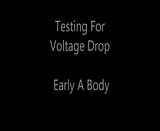Had the same problem. I had a bad ground between the regulator and firewall.
tmm
tmm
Had the same problem. I had a bad ground between the regulator and firewall.
tmm
...Checked resistance from VR to chassis-2.8 ohms...
dunno how much more this thing can be grounded
I need to brush up on my Ohms Law..
Ok look, you have to get this down to "the basics" and go from there.
1--There is SOME possibility that the battery itself could cause this, so try a known good battery out of another vehicle temporarily.
2--The regulator itself could be a problem, but you have replaced that.
3A--This leaves the sense voltage
3B--and the ground between the regulator and battery.
YOU MUST CHECK THESE in the following manner!!!
A---To check the sense voltage, Turn the key to run, but with engine OFF. Stab one probe of your meter into the battery POS post, and clip your other probe to as close to the regulator IGN terminal as you can get. Since you are having so much trouble, I'd be tempted to stick a pin through the blue regulator wire in an attempt to eliminate as much as possible.
Again, you want to see LESS than .2V, the less the better.
More voltage means you have a voltage drop problem in the harness. Your top suspects are the regulator connector, the bulkhead connector, the ammeter circuit, the ignition switch connector, and the switch itself. Also check the connections at the coil resistor. That is, the crimps in the connectors
B---To check the ground, get the engine running, the battery charged, and do the following check twice, first with everything in the car shut off (except the engine) and again with heater, lights, etc turned on.
Stab one probe of your meter onto the NEG. battery terminal, and stick the other probe directly onto the mounting flange of the regulator. You should read less than .2V (two tenths of a volt). More voltage means the regulator is not actually grounded to the battery NEG.
Couldn't possibly run if the coil was grounded. You'd get no spark.years ago I had a ign coil short to ground. It caused the alt to charge like a sumbich. Just something to check if you have a spare coil. Btw the car ran fine.
Well, I did bypass it by doing exactly what you mentioned-I ran an 8ga wire directly to the battery side of the starter relay...however, I retained the other 10ga wire that ran thround the bulkhead with a fuse link so I could keep the circuits fed by it inside the cab since it feeds the fuse box.
After all this nonsense, I'll probably run that wire over from the starter relay as opposed to the alternator charge post...
...............3A. With key on, engine off voltage loss measured at <TADA!!> 1.1V when probed between (+) battery terminal and IGN voltage measured 1" from VR connector.................
So, I might be going after an ignition switch.
Running a jumper from the battery to the starter relay does NOTHING. Please re--read my post
You did the ammeter bypass correctly. You are right that you need to leave both cables going into the cabin, since that is the only way to power the cabin. Actually, you probably need just the ALT cable since all loads come off that. The BATT cable is in series with the ammeter, to measure all flow into or out of the battery to the cabin, the only exception being special accessories like spot-lights. For hard-core electronics types, I pioneered a way to keep your ammeter working yet start bypassing it at higher currents (search).please re-read that post as it is a reply to Bill...not a statement saying I ran a jumper from the battery to the starter relay. I'll confess to not being the brightest bulb in the box when it comes to troubleshooting electrical components, but I'm also not that lost...thanks

Cool video...I performed that test yesterday and found 1.1V drop.
I slaved in a new ignition switch this morning and found no difference in the operation or votage, so I have a connection or wire somewhere in there that's probably toasty. I'll get after it again (hopefully) this weekend in between doing favors for folks...
Tell us what you don't understand.I've read and reread this thread, to bad i'll never understand itSon just blew out 2 new headlights when ammeter pinned it self.
overall loss from batt (+) to VR = ~1.1V key on, engine off............................
loss from batt (+) to firewall side of bulkhead connector ign wire = ~ 0.45V.
The measurements really help. I doubt you need another harness, unless the insulation on your wires is old and brittle. The copper should be fine. You just need to clean the connectors, and maybe solder the crimps. You can remove the terminals from the bulkhead connector fairly easily by squeezing the long way w/ needle-nose pliers. Look at photos of "56 terminals" on ebay to understand. Label the connector w/ a Sharpie A-H and record the color wires before removing, or do 1 at a time. Spray Contact Cleaner in female terminals or ones you can't remove.In any case, looks like I'll be shopping for an ignition harness before I can make any headway with it.
